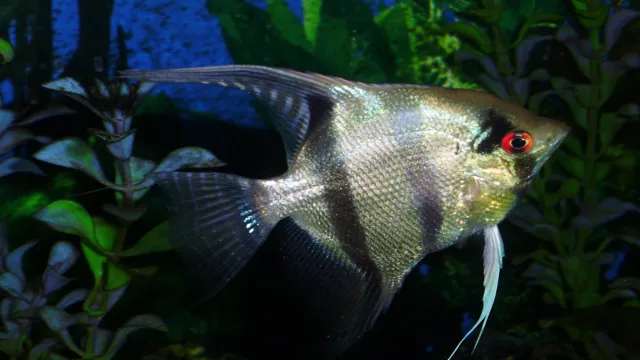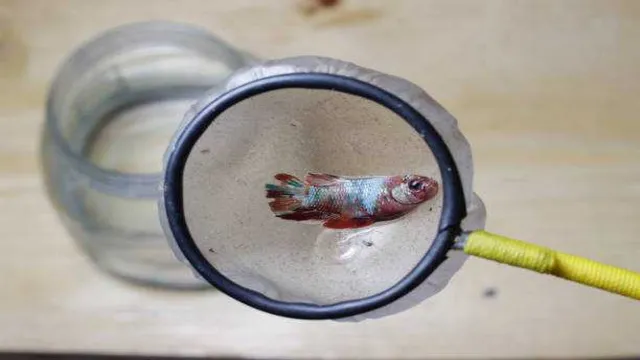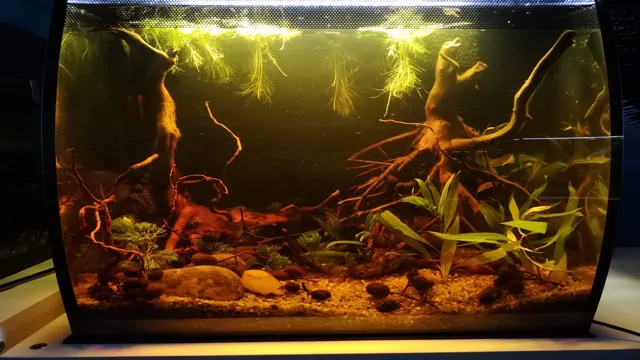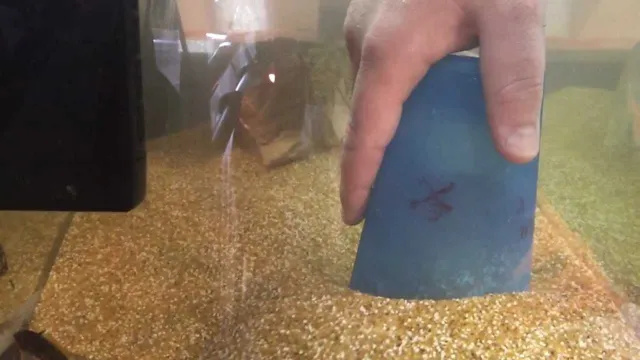If you’re looking to add some new life to your aquarium, consider breeding angelfish! These beautiful fish are a popular choice for hobbyists, and breeding them can be a rewarding experience. But before you get started, there are a few things you should know. From creating the right conditions for breeding to caring for the offspring, breeding angelfish requires careful attention to detail.
In this article, we’ll explore everything you need to know to successfully breed angelfish in your aquarium. So, if you’re ready to take on the challenge of raising these stunning fish, read on!
Preparing Your Aquarium for Angelfish Breeding
Breeding angelfish in an aquarium can be an exciting and rewarding experience for fish enthusiasts. However, it takes a bit of effort to prepare the tank and create the right conditions for the fish to breed. Firstly, make sure the tank is large enough to accommodate the mature angelfish pair and their potential offspring.
You’ll need to provide hiding spots or plants as they prefer to lay their eggs on vertical surfaces. Water quality and temperature are also crucial factors, with the ideal range being 78 to 80 degrees Fahrenheit, and a pH range of 8 to
Angelfish are known to be sensitive to any water parameter changes so maintain water conditions regularly. Once the breeding pair has been established, ensure they are well-fed with a diet consisting of brine shrimp, bloodworms and other protein-rich foods.
It may take a few attempts before angelfish are successfully bred, but with proper preparation and care, it’s definitely worth trying.
Choosing the Right Tank Size and Set-Up
When it comes to breeding angelfish, one of the most critical factors to consider is the size and set-up of your aquarium. These fish require a spacious tank with plenty of hiding spaces and suitable water conditions for mating. Typically, a tank size of at least 20-30 gallons is recommended for a breeding pair of angelfish, with additional space for any fry that may hatch.
You’ll also need to ensure that the water temperature and pH levels are appropriate for breeding, which can vary depending on the specific breed of angelfish you’re working with. Additionally, it’s important to provide your angelfish with a variety of foods and proper lighting conditions to encourage healthy breeding habits. By setting up your aquarium properly and providing your angelfish with the ideal conditions, you’ll be well on your way to successful angelfish breeding.

Acquiring and Condition the Breeding Pair
Preparing your aquarium for angelfish breeding can be a bit of a challenge. Before you can begin breeding, you need to acquire a breeding pair and ensure they are healthy and ready to mate. You can acquire angelfish breeding pairs from reputable breeders or pet stores.
When choosing your breeding pair, make sure they are physically healthy and mature. The male and female should be roughly the same size, and both should have a good body shape. Once you have your breeding pair, you need to make sure your aquarium is the right environment for them to breed.
Provide plenty of hiding places and plant life for the angelfish to lay their eggs. It’s also essential to maintain good water quality and temperature as this can affect the breeding success. Finally, make sure your breeding pair is well-fed with a variety of nutritious foods, such as bloodworms and brine shrimp.
With the right preparation and care, you can successfully breed angelfish in your own aquarium.
Optimizing Water Conditions for Breeding
To successfully breed angelfish in your aquarium, optimizing the water conditions is essential. First, you need to ensure that the water temperature is between 78-82°F and the pH levels are between 5- (See Also: How to Get Snails Out of Fish Aquarium: Tips and Tricks for Safe and Effective Removal)
0. These are the ideal conditions for angelfish breeding as they simulate their natural habitat in the Amazon River basin. It is also important to maintain the water quality by performing regular water changes and using a good filtration system.
Add some plants and hiding places to provide a comfortable environment for the fish to lay their eggs. Don’t forget to feed them a protein-rich diet to promote healthy growth and reproduction. Breeding angelfish can be a challenging but rewarding experience, so make sure to keep a watchful eye on them and be patient.
With the optimal water conditions, your angelfish will thrive and spawn for years to come.
The Breeding Process of Angelfish
Breeding angelfish can be a simple and rewarding experience for aquarium owners. First, it is important to select healthy and compatible angelfish with the desired traits. Once you have selected a breeding pair, it is important to prepare the breeding tank with clean and conditioned water.
The ideal water temperature should be maintained at 78 to 82 degrees Fahrenheit. The breeding pair should be well-fed with high-quality food to increase their chances of successful breeding. Angelfish prefer to lay their eggs on a vertical surface such as a piece of slate or breeding cone.
Once the eggs are laid, it is important to ensure that the water quality remains stable and that the eggs are not disturbed. The eggs should hatch within 48 to 60 hours, with the fry swimming freely within 72 hours. Raising the fry requires an attentive and dedicated caretaker, with feeding and water maintenance schedules being followed diligently.
Overall, breeding angelfish requires attention to detail, patience, and proper preparation.
Recognizing and Triggering Spawning Behavior
Angelfish breeding is a delicate process that requires patience and attention to detail. In order to successfully trigger spawning behavior, certain conditions need to be met, such as maintaining a stable water temperature and pH level. Additionally, it is important to recognize the signs of readiness in a male and female pair of angelfish, which may include increased aggression towards other fish and frenzied swimming patterns.
Once these conditions are met, angelfish typically begin to pair off, swimming closely together in a courting dance. As the breeding process progresses, the male and female will eventually lay and fertilize their eggs, which will hatch in approximately two to three days. Overall, the breeding process of angelfish can be both challenging and rewarding, as successful breeding can lead to healthy, vibrant fish that are a joy to watch and care for.
Managing and Caring for the Fry
Angelfish breeding can be a thrilling experience for any fish enthusiast. The process begins with selecting a suitable pair of angelfish and providing them with a comfortable environment that mimics their natural habitat. As they mature, the pair will eventually start to bond and become territorial around their breeding area.
During this time, the female will begin to lay eggs, which the male will fertilize. It’s important to keep the breeding area clean and free of debris and excess food, to prevent contamination and disease. Once the eggs are laid, the parents will fan them with their fins to provide oxygen and keep them clean.
After a couple of days, the eggs will hatch into fry, which must be carefully managed and cared for. Fry are delicate and require frequent feeding in small amounts, with strict water quality monitoring to ensure that they are growing healthily. An angelfish breeder must be attentive to changes in the fry’s behavior and appearance.
It’s also important to separate the fry from the parents to prevent them from being eaten. Breeding angelfish is not without its challenges, but with patience and dedication, it can be a rewarding experience. Through careful management of the breeding process and attentive care for the fry, angelfish enthusiasts can breed this beautiful species and contribute to the diversity of the fishkeeping community. (See Also: How Thick Should Substrate Cap Be Aquarium? Complete Guide and Tips)
Whether you are a seasoned breeder or a beginner, make sure to provide your angelfish with the best care possible, and they will reward you with a lifetime of beauty and grace in your aquarium.
Common Issues and Troubleshooting Tips
Breeding angelfish in an aquarium can be both rewarding and challenging. One common issue that many beginner aquarists face is maintaining optimal water conditions for their angelfish. These fish require a pH range of
5-5 and a temperature range of 75-82°F. It’s important to monitor these levels regularly and make adjustments as necessary to ensure the comfort and health of your fish.
Another challenge can be getting your angelfish to spawn. They are known for being picky about who they choose as a mate and also require specific spawning conditions such as a flat surface for egg laying and a high protein diet. Some tips for encouraging spawning include providing plenty of hiding spots and plants for the fish to feel secure, and gradually increasing the water temperature to trigger breeding behavior.
With patience and careful attention to detail, breeding angelfish in an aquarium can be a rewarding and enjoyable experience.
Frequent Issues Faced during Angelfish Breeding
Breeding Angelfish Breeding angelfish is a great hobby for enthusiasts to indulge in. However, it comes with its own set of problems. A significant challenge faced by anglers during the breeding process is the lack of compatibility between the mating pair.
This can lead to fights or one of the pair’s refusal to breed. It’s essential to pair up healthy fish with matching patterns and sizes to ensure successful mating. Another issue could be cloudy water caused by excess uneaten food or organic waste material.
This can lead to the death of the fry or the spread of diseases. Regular cleaning and water changes can prevent this problem. Lastly, newly hatched fry are vulnerable to attacks from other fish.
Separating them from adult fish or providing adequate hiding spots can solve this issue. With patience and care, anglers can enjoy watching their healthy angelfish fry grow into fully grown adults.
Possible Solutions to these Issues
When it comes to technology, there are bound to be some issues that arise. Fortunately, there are always solutions! Here are some common issues and troubleshooting tips to help you resolve any technological hiccups you may experience. If your device isn’t turning on, try plugging it in and charging it for a bit.
If it still doesn’t turn on, try holding down the power button for a few seconds. For slow internet speeds, try resetting your router or modem. If that doesn’t work, try moving closer to your router or upgrading your internet plan.
If your computer is freezing or crashing, try clearing out old files and programs, running a virus scan, or updating your operating system. Remember, if you’re ever unsure about how to fix an issue, you can always reach out to customer support or consult online forums for additional help. With a little troubleshooting, you’ll be back up and running in no time! (See Also: How to Maintain a Small Fish Aquarium at Home: Expert Tips and Tricks)
Conclusion and Maintenance Tips
So, there you have it! Breeding angelfish in an aquarium may seem like a daunting task, but with the right knowledge and preparation, it can be a truly rewarding experience. Remember to provide your fish with a comfortable and conducive environment, to carefully select your breeding pair, and to closely monitor their behavior and spawning patterns. With a little bit of patience and a lot of love for your fish, you may just be successful in producing some beautiful and healthy angelfish offspring.
Who knows, with a little more practice and a lot more dedication, you may even become the ultimate angelfish breeder in your community! Happy fish breeding!”
FAQs
What is the minimum tank size required to breed angelfish in an aquarium?
The minimum tank size required to breed angelfish in an aquarium is at least a 20-gallon tank.
What should the water parameters be for successfully breeding angelfish in an aquarium?
The water parameters for successfully breeding angelfish in an aquarium should be a pH level of 6.0 to 7.5, temperature between 78-80°F, and hardness level between 3 to 6 dGH.
How many angelfish can be kept in a breeding tank?
You can keep a pair of angelfish in a breeding tank, or up to 8-10 juveniles in a grow-out tank.
What type of food should be given to breeding angelfish in an aquarium?
Breeding angelfish should be fed a high-quality diet consisting of live or frozen foods such as brine shrimp, bloodworms, and daphnia.
How long does it take for angelfish eggs to hatch?
Angelfish eggs usually hatch within 48 to 72 hours after being laid.
What is the ideal breeding age for angelfish?
The ideal breeding age for angelfish is between 8 months to 2 years old.
How often should water be changed in a breeding tank for angelfish?
It is recommended to change 25% to 50% of the tank water every week to maintain good water quality for breeding angelfish.







